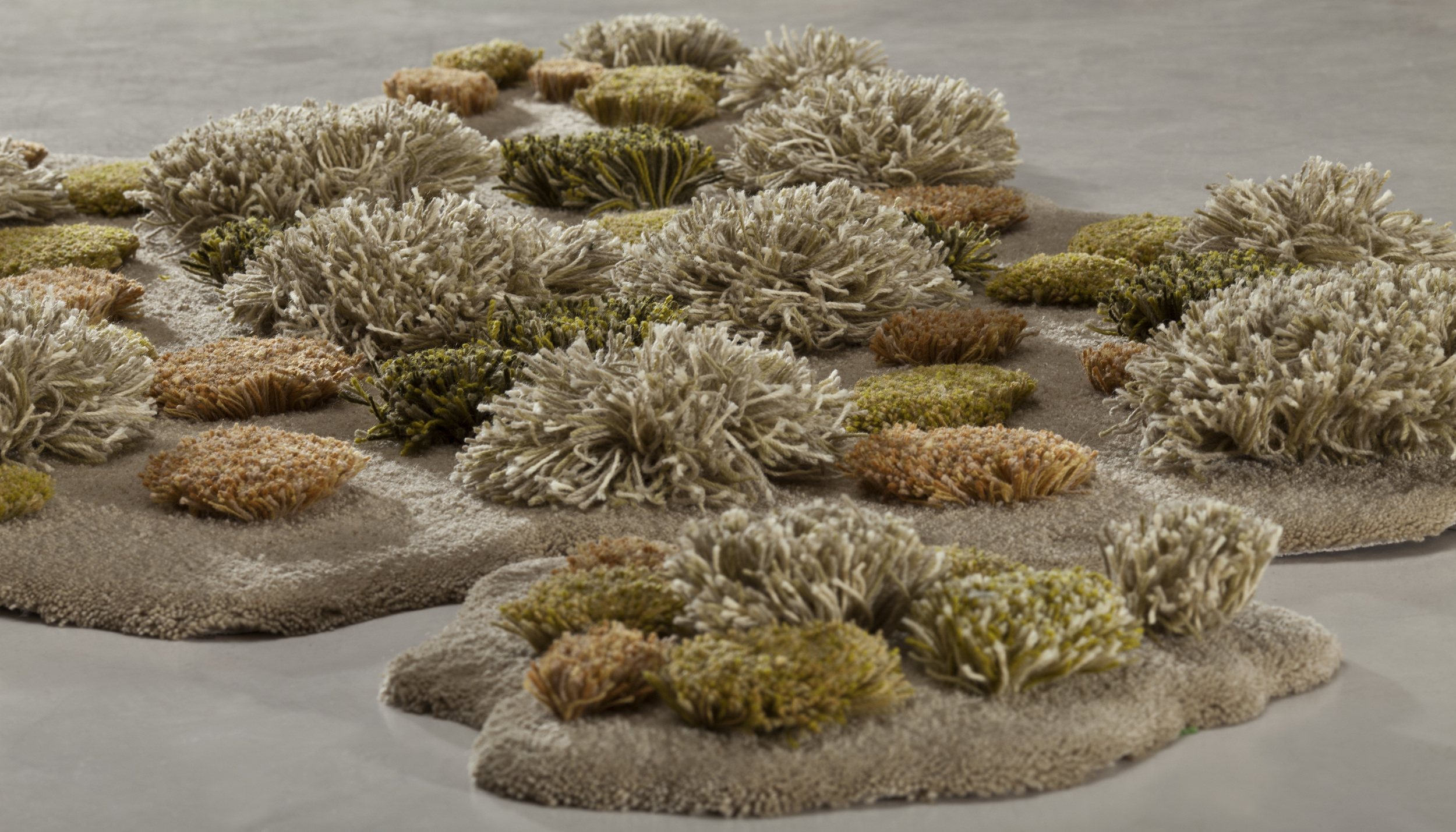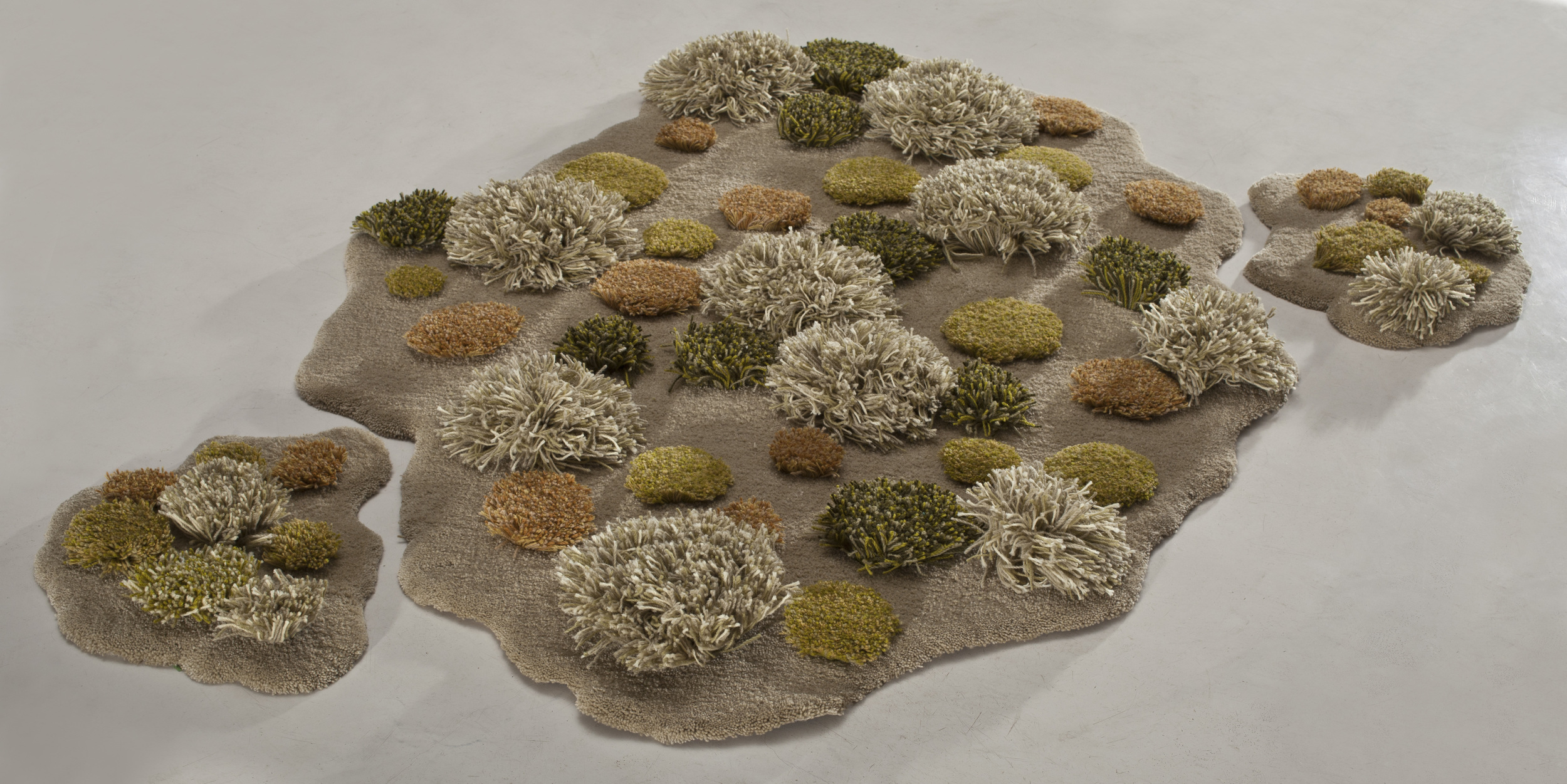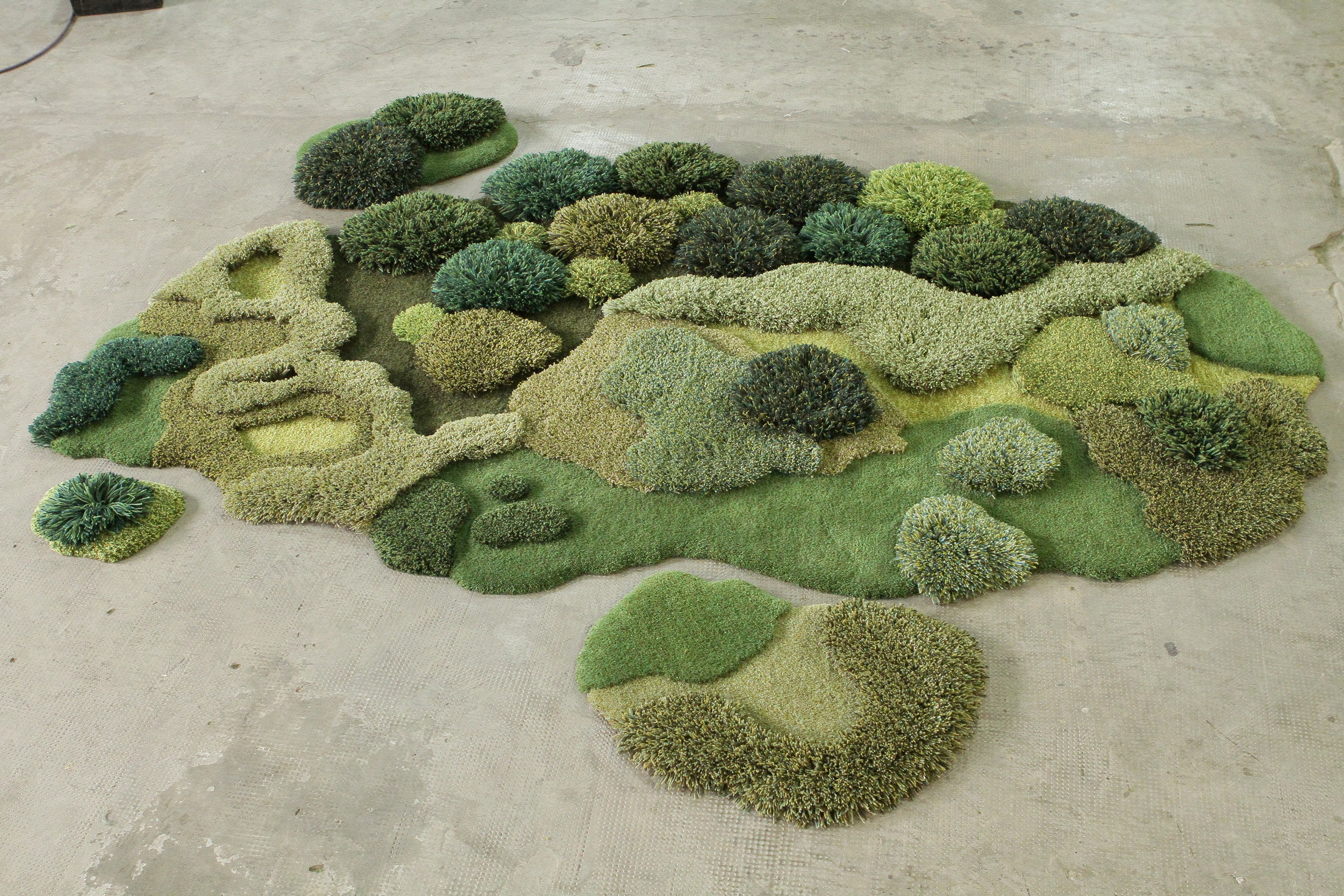How to connect the dots between nature, sustainability and carpet making? By reinventing cherished childhood territories from leftover textiles of her family-owned factory, Argentinian rug artist Alexandra Kehayoglou gives an answer to this seemingly impossible equation. It’s in the Studio Kehayoglou, where the hands work hard and artisanal immaculacy bravely takes shape, stopping the passing of time in ethereal still-life carpet artwork.
Your carpets are pure magic. How does the process of creating one begin?
Every piece has a story behind it and the whole process that leads to the final result is rather long and complex. [In my approach], the original techniques of tufting are combined with modern technology. I try to link both platforms — the industrial and the manual — to create more experimental artworks. My greenlands, paddocks, shelters and tapestries are made up from retrieved material of the factory owned by my own family. In a way, they contain my own life experience.
I usually have a previous idea of what I want to achieve [as a final result], but this always changes through the process. I first sketch on the canvas, then apply the tones and create textures inspired by landscapes I’ve seen. The textile is weaved with handtuft system — with a pistol that I manipulate on vertical racks to create the weft that will give shape to the final piece. Each of them is unique, with a certain texture, pattern, volume and unrepeatable palette.
When did you start connecting and exploring the symbiosis between landscapes and rug making?
I grew up among rugs. Seventy years ago, my Greek family brought the tradition of designing and producing the carpets to Argentina. After many years of research, I decided to transform my family history into an artistic expression.
Everything started with my diorama boxes in which I tried to freeze a scene. An artificial miniature beach landscape in which the spectator could submerge, but these were at first [merely a] model — they were small and packed in a box. When that tapestry unfolded on the floor, I realised I could create those landscapes, following the same idea of time being frozen, but this time in a human scale. Therefore I decided to keep my cherished territories from childhood safe from the passing of time by recreating my landscapes.
How is the sustainability element represented in your artwork? What other principles do you consider to be the cornerstone of your art?
Sustainability is present in each piece of work. I am deeply conscious about nature and that is why I hand-tuft my pieces with 100% natural sheep wool and all the materials are surplus from my family’s factory. The materials are selected carefully and then dyed to achieve the desired colours.
How long does it take to create one masterpiece rug? What's the most complex project you have undertaken and completed?
Depending on the complexity of the piece, the production time can take from one to several months. I pay a lot of attention to details and I am extremely tedious with each and every stitch. The most complex project I worked on was a custom-made carpet designed by Olafur Eliasson and crafted by Alexandra Kehayoglou’s Studio. It consisted of a 3D carpet, which we had to adapt to a wooden topography to create a reading space in the Art Kunz Library of Berlin. This was truly challenging, because we had to develop a new method for the carpet installation. All in all, it was a great experience; we spent almost three weeks at the Studio. We worked a lot!
“Each of them is unique, with a certain texture, pattern, volume and unrepeatable palette.”
What makes a particular landscape inspiring enough for one of your rugs? What else inspires you throughout the process?
I guess the contemplation of the landscapes I love is the first step for the development of my work. Also, Argentinian geography has been very inspiring for me because, in a way, my personal history is tightly related to the history of that land. Walks through my parents garden with my son, road trips, sunsets, aerial views, the sea, the beach, my family, my grandmother, are part of this dialogue between nature, tradition and art.
You also have an inspiring Instagram account. In your view as an artist, is it important to promote yourself more as a 'brand' nowadays? Don't you feel that it has made your work more commercial?
I believe all art is very much about freedom. In a way, Instagram is a great tool for any visual artist, because it allows us to choose what we want to share about our daily work at the studio — it’s sort of a visual diary. During the last few years, artists have found new ways of creating the ‘buzz’ and circulation, it’s not merely about being a part of a gallery anymore. Even though my work is sometimes related to important brands, I really don’t find my work commercial at all. In fact, it is well known that there are new models of art business arising and concurrently with them, new ways of being an artist.
“Walks through my parents garden with my son, road trips, sunsets, aerial views, the sea, the beach, my family, my grandmother - all are part of this dialogue between nature, tradition and art.”
Describe the relationship between fashion and your rugs. There was a runway setup project you've done for one of the major fashion brands. Are there any other fashion collaborations you’ve executed?
In 2014, Dries Van Noten contacted my studio through a fashion producer called Villa Eugénie, who had seen my work online. They asked for a rug of 50 meters based on the same nature concepts that I work on. The design of the carpet was a pastizal (grassland/pasture). We travelled to Paris for the installation of the piece. It was a great experience because, even though the process was very intense and it had to be developed in a very limited timeframe, a new way of thinking my work appeared [as a result].
How can we be more environmentally aware and shape people's mindsets through what we put out in the world?
I think we should start with small actions. Every day is a chance of making things better. If we finally understand that we are not the centre of the Earth, but just a tiny part of it, as well as the trees, the animals, the rivers and seas and the mountains, our decision-making and behaviour will lead us to living a more environmentally-conscious life.
“I decided to keep my cherished territories from childhood safe from the passing of time by recreating my landscapes.”
What's your relationship with nature?
I was raised in a house with a big garden, so my approach to nature is quite sincere and spontaneous. As a child I used to explore the different colours, shadows, smell of the grass, the flowers and plants. Everything was special and new, my point of view was not contaminated by life experience. I remember making up stories for hours, nursing the birds, playing with mud. The feeling that time was frozen in a special moment is something I’ve been trying to transmit with my work as part of that first intuition.
In what ways has Argentina played a role in shaping you as an artist?
Argentina offers many kinds of climates, landscapes and cultures. I decided to embrace this diversity because it’s also a part of my own identity. The scenes I create are part of native territories that carry ancestral information and I think that my job as an artist is to transmit their message through the best language I know, art.








